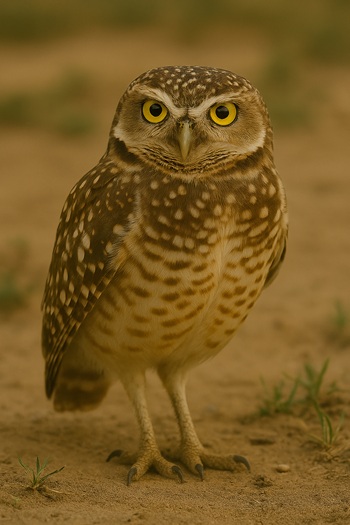
Burrowing owls are not only intriguing but also full of interesting quirks and facts that make them stand out in the avian world. Enjoy these fun facts about burrowing owls:
Diurnal Lifestyle: Unlike most owl species that are nocturnal, burrowing owls are primarily active during the day, earning them the nickname “day owls.” They are most active during the early morning and late afternoon.
Long-Legged Runners: Burrowing owls have exceptionally long legs compared to other owls. These long legs make them skilled runners, allowing them to chase after prey on the ground with surprising speed.
Mimicry: When threatened, burrowing owls often mimic the sound of rattlesnakes by hissing or shaking their bodies to deter predators from approaching their nests.
Home Improvement: Burrowing owls are known for their penchant for decorating the area around their burrows with objects they find, such as bones, dung, and even shiny pieces of trash.
Sunbathing: These owls are known to engage in sunbathing behavior, where they stretch their wings and bask in the sunlight, possibly to regulate their body temperature or aid in feather maintenance.
Complex Vocalizations: Burrowing owls have a wide range of vocalizations, including various cooing sounds, chattering, and whistles. Their vocal repertoire is quite diverse for such small birds.
Ground Nesting: They are one of the very few owl species that nest in the ground. They often take over burrows abandoned by other animals, such as prairie dogs, and modify them to suit their needs.
Multiple Burrows: Burrowing owls may have several burrows within their territory. These extra burrows serve as escape routes and can confuse predators.
Communal Living: In some cases, burrowing owls live in colonies with multiple pairs occupying nearby burrows. This communal living can provide extra protection and increased vigilance against predators.
Conservation Concerns: Many populations of burrowing owls are considered threatened or endangered due to habitat destruction, urbanization, and other human-induced factors. Conservation efforts are crucial to their survival.
Lifespan: In the wild, burrowing owls typically have a lifespan of around 6 to 8 years. In captivity, they can live longer, sometimes up to 10 years or more.
Adaptable Diet: While they primarily feed on insects and small mammals, burrowing owls are opportunistic hunters and may also consume small reptiles, amphibians, and birds when the opportunity arises.
These fun facts highlight the uniqueness and charm of burrowing owls, making them a beloved species among bird enthusiasts and a valuable subject of study for researchers and conservationists.
Related Articles & Free Email Newsletter Sign Up
Majestic Predators of the Night: The Great Horned Owl
The Barred Owl, Also Known as the Hoot Owl Has a Distinctive Call
The Kestrel is a Marvel of Adaptation and Ecological Balance


Comment here